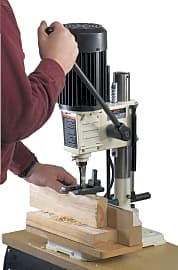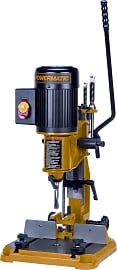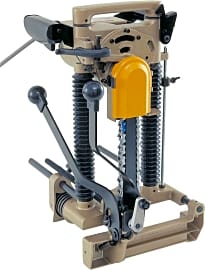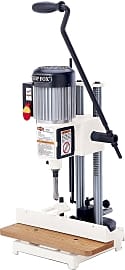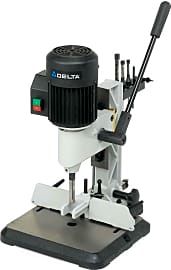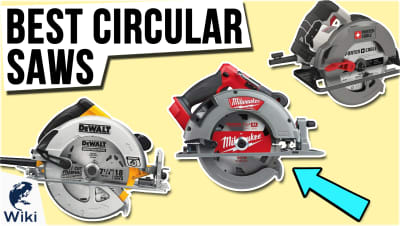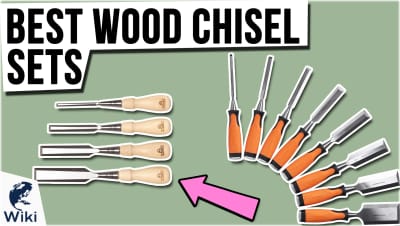The 8 Best Mortising Machines

This wiki has been updated 47 times since it was first published in March of 2015. If you're looking to connect two pieces of wood together to build things like furniture, doors, and windows, the quickest, most efficient way is the use of a mortising machine. Here we have included a range of benchtop and floorstanding mortisers that will suit just about every need, all of which will allow for accurate cuts and the creation of joints in a variety of stock. When users buy our independently chosen editorial selections, we may earn commissions to help fund the Wiki.
Editor's Notes
November 06, 2020:
Today the Porter-Cable 513 was added to the list, and it’s designed with entry door lock installations in mind. It’s from a well-known name in circular saws, belt sanders and other power tools. Featuring an 11-amp, 27,500 RPM motor, it can cut mortises up to seven inches in length that are up to 1-1/4 inches wide and 4-3/4 inches deep. It automatically centers the cutter on the door’s edge, and sports a durable steel and alloy build that can be counted on to produce reliable, accurate results for years. It carries both a 90-day money-back satisfaction guarantee and a generous three-year warranty. With it, you’ll get a 3/4-inch bit and a one-inch bit, as well as an Allen wrench. Note that it does not come with any dust collection bin, and some users have gone so far as to create a homemade one to attach to it.
We kept the Powermatic 719T in a prominent spot in this update, thanks to its strong cast iron construction and long-lasting induction motor. It’s a good choice for anyone who makes angled mortises, and incorporates an integrated swiveling vise clamp and a large table and fence. The benchtop Powermatic PM701 is another reliable model from the same manufacturer, and it's made with a reversible handle that allows for use by both left- and right-handed users. Its generous length ensures good depth control. For a lightweight, yet rugged, model, look to the Jet JBM-5, which clocks in at under 45 pounds and features a reversible column for handling larger workpieces, as well as two hinged steel doors that provide access to the chuck.
For safety’s sake, when using a mortising machine, do not wear loose clothing or jewelry. Wear certified safety glasses and proper hearing equipment. Always disconnect the device’s plug from the power source before making any adjustments or changing accessories. During use as well as storage, keep these machines safely out of the reach of children. Regularly check the device for damage or misalignment, and have any necessary repairs made before resuming operation.
July 25, 2019:
Mortising is the woodworking equivalent of square broaching in metalwork. Making square holes is tricky, but desirable for the creation of high strength joints. You can cut them out by hand with a chisel and mallet but it takes time and patience. Instead, manufacturers have given us machines like the Powermatic 719T and the Jet JBM-5 that use hollow-chisel mortisers. These function by using mortising bits that consist of a square hollow chisel that squares the edges and a special drill bit that leads the cut and removes wood shavings. A long handle grants the user mechanical advantage for plunging the cut.
The Makita 7104L is an excellent tool with plenty of power and it helps create through mortises very quickly. The primary reason it is ranked third and not higher is that it has an important limitation: it is not great at making blind mortises and this severely limits its appeal. The rounded chain bar means that the bottom of the mortise will also be rounded and so it will be necessary to go in with a regular hand chisel and mallet to square the bottom off.
Mortising machines are dangerous and should only be used by trained professionals. Breathing protection should be used when working on wood to avoid inhaling harmful particles.
Understanding Mortising Machine
When they turn the machine on and place the bit on the timber, it creates a clean, symmetrical hole that is ready for a tenon.
Mortising is the act of putting a hole or recess into one item so that a tenon can fit inside of it. The technique gets its name from the mortise and tenon joint, one of the most commonly used joints by woodworkers. Through this method, two pieces of wood are usually connected at a 90-degree angle. If one wanted to build a table, they would have to mortise a leg before attaching it to the top. A mortising machine uses a motor to drill a rectangular or square hole into a piece of timber.
The user attaches a drill bit that corresponds to the size and shape of the hole they need to the motorized rotator on the machine. When they turn the machine on and place the bit on the timber, it creates a clean, symmetrical hole that is ready for a tenon. Depending on the project, the user may want more or fewer rotations per minute. A mortising machine also has a base that clamps onto the timber so that the wood stays still while the hole is put in place. Some models offer bases that swivel so the user can rotate the piece of timber and drill holes in different areas, without having to take it out and reposition it.
There are three main types of mortising machines: the square chisel, the horizontal (or slot) and the chain. The square chisel model resembles a drill press in its fixed style. It contains a chisel that ensures clean and straight edges and a drill that creates the hole. The horizontal mortiser has a router mounted on its side, and a workpiece attached to a multi-axis sliding table. This type of machine is best for floating tenons, which are created when two pieces of wood have corresponding mortises that must be attached via a third piece of wood. Chain models are best for large scale construction projects. They use chainsaw-style rotating cutters that simultaneously hold onto and cut the piece of wood.
Woodworking Safety Tips
Any woodworker, professional or a hobbyist, should wear goggles, a dust mask, and ear protection. If a tiny piece of wood flies into one's eye, it can cause severe damage to the cornea. Dust in the lungs may sound harmless, but it can be very dangerous. Because dust particles are so small, they can make it past your body's initial filters, like the nose and throat. Dust from a workspace can also contain toxins and fungi that can cause several infections like histoplasmosis, Q Fever or psittacosis.
One should also never walk away from a machine that's been left on, nor should they use a tool until it is running at full speed.
Those new to woodworking might be shocked by how loud their equipment can be. That noise isn't only a nuisance, but it can cause damage to one's hearing, which is why wearing some form of ear protection is important. In fact, power tools are listed as some of the top items that can cause hearing loss. There are a few things woodworkers should not wear, like scarves, ties or long jewelry. If these items become caught in a mortising machine, they can quickly pull the wearer towards the cutters which can result in serious injury.
Don't keep electrical cords on the floor. If someone were to trip on these, they could knock over active cutting machines causing in injury to you or others. One should also never walk away from a machine that's been left on, nor should they use a tool until it is running at full speed. Tools are designed to give the user complete control only once they're running at their intended speed. Using one before that can cause the material being worked on to slip.
The History Of Woodworking
Woodworking is a craft nearly as old as humankind. Anthropologists who studied tools used by neanderthals found that even these ancient ancestors worked with wood. The oldest manmade wooden artifacts on record are 400,000-year-old spears that were found in the German town of Schöningen. Germany is the site of several ancient wooden artifacts, including coffins from the Bronze Age and animal statues from the Iron Age.
Copper and bronze tools have been found from 2000 BCE that historians believe were used for carving wood.
Ancient Egypt is also thought to have been a pioneer in woodworking. Copper and bronze tools have been found from 2000 BCE that historians believe were used for carving wood. Woodwork shops are also depicted in Ancient Egyptian drawings. People from the predynastic period (spanning the earliest human settlement to 3100 BCE) likely used mortise and tenon joints. This culture quickly deforested the Nile valley, and by the time the Second Dynasty was founded, they needed to import wood.
The Ancient Romans relied on wood as their main building material for most home construction. They used it to make pipes, waterproofing materials, tools, dye, and, of course, heat. The Roman architect Marcus Vitruvius wrote a full chapter on timber in his book "De Architectura," written sometime between 30 and 15 BCE. Ancient China also boasts a book on woodworking. A man named Lu Ban, who likely lived sometime between 771 and 476 BCE, allegedly wrote the book "Lu Ban Jing," in which he introduced the concept of the plane and chalk lines.


